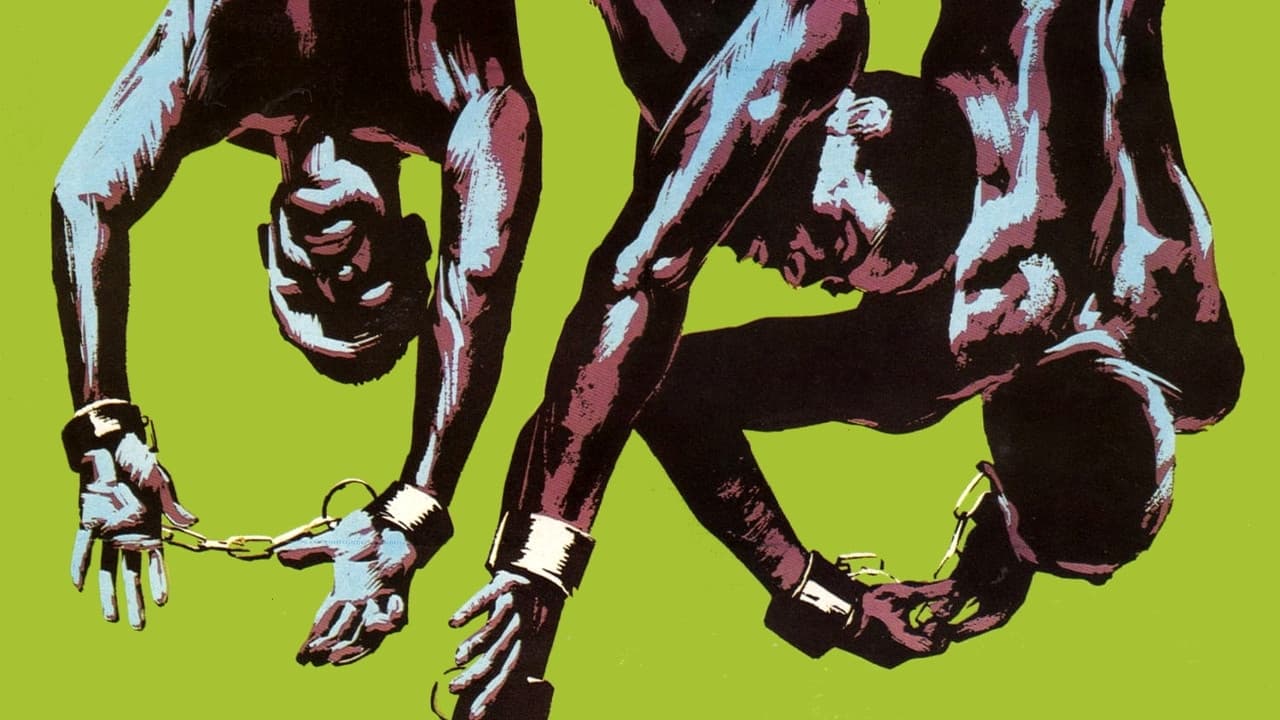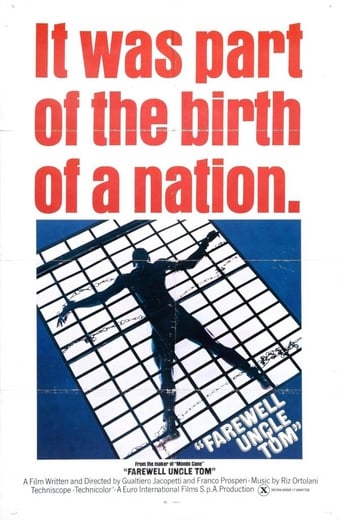Freaktana
A Major Disappointment
Kidskycom
It's funny watching the elements come together in this complicated scam. On one hand, the set-up isn't quite as complex as it seems, but there's an easy sense of fun in every exchange.
KnotStronger
This is a must-see and one of the best documentaries - and films - of this year.
Orla Zuniga
It is interesting even when nothing much happens, which is for most of its 3-hour running time. Read full review
The_Void
Goodbye, Uncle Tom is one of the Mondo films released in Italy in the seventies. I'm not a fan of this type of film and therefore I've only seen a handful of them - however, from my basic knowledge of the genre; this one is way above average and actually delivers a good film to go along with the numerous shocks. I have to be honest and say that the central theme doesn't really interest me. The film is basically an exploitation style documentary the American South prior to the civil war and primarily focuses on the slave trade. I don't know a great deal about this period of history and so I can't say how accurate this film is - but really it doesn't matter. While the film follows a documentary approach; that's really not the strongest element of Goodbye, Uncle Tom. The film, for me, is all about style and directors Franco Prosperi and Gualtiero Jacopetti lay this style on thick and it really works brilliantly. The music (excellent score by Riz Ortolani) and the cinematography are fascinating, and this is a real bona piece of seventies Spaghetti film-making.Films like this are generally designed to shock the viewer, and that is certainly the case here. The central theme allows for plenty of shocks and the most shocking scene on a visceral level is probably the rape sequence. However, the core of this film's ability to shock stems from the premise upwards and it's uncomfortable, especially in these times, to see how black people were once treated by their "masters". A scene in which a slave trader explains what his slaves are worth in the same way a cattle rancher might try and sell his stock, and why you cannot train an Indian to be a slave is the most shocking in this respect. It's hard to really rate the film alongside others in terms of acting and the script; but suffice to say, everything shown in the film is very realistic and it wouldn't be hard for an audience to believe that the film is taking place in pre-civil war America (if it weren't for the fact that film-making equipment was not invented back then, of course). Overall, Goodbye Uncle Tom is a great piece of exploitation that shocks, thrills and intrigues in equal measures. Highly recommended viewing.
haildevilman
This is not real. But it was. That's the rub.A chopper goes back in time to the slavery days of America. The pre Civil War years when blacks were basically livestock.Slaves are bought, sold, traded, and given away as gifts. No concern for the families being broken up so callously. And the traders thought this was God's will. A preacher even affirms this.They eat the back end of the crops. And if they refuse, they get force fed. These scenes are hard to watch because of the violence and the grossness. But it DID happen that way.Of course you have your whipping scenes. Seems ordinary, but remember, the blacks weren't criminals. They were people like the rest of us. They did nothing to deserve their plight.What shocked me was watching the owners grab body parts like they were looking for ripe veggies. And check their teeth and eyes like they were buying a race horse.Shock-o-rama. And mostly because it's true.
jaibo
In Goodbye Uncle Tom, two documentarists "travel" to the old American South and explore the slave economy. This world is recreated in all of its brutal and corrosive details, from the shipping to America of slaves in the hulls of ships - the sickening conditions with diarrhoea-ridden slaves chained in their own filth is emphasised - to the brothels where large Mammies coral underage girls for the delectation of white clients. The film is made on an enormous scale. The scenes in the slave markets and on the plantations have literally hundreds of extras, and the marshalling of crowds alone makes the film an exceptional achievement. This is no low-budget cheap-flick but a full, cinemascope extravaganza featuring vast hordes of extras, sweeping crane shots and unfeasibly intricate dolly shots which travel through large sets and teaming crowds, a swarming mass of human flesh, the sheer scale of which leaves one's mouth dropped open in wonder. That wonder is turned into awed disbelief as the brutal, nerve-wrecking content of the film unfolds before one's eyes. This is Gone With The Wind mixed with a supersized portion of Salo.The film is completely plot less. It features a series of set-pieces - all based on research into actual conditions, events and personages - each of which show an aspect of the slave trade. A bustling church has a preaching pro-slavery Pastor presiding over the gelding of African bucks. A mansion is filled to the brim with dozens of slaves, making beds, cooking dinner and helping Missies to dress. A group of nasty-looking rednecks roam a swamp, massacring escaped "merchandise." The scenes get nastier as the film progresses - which seems to be the only logic to the film's progression. There is a particularly insane sequence in which a "veterinary" tells us of his work on the slaves, a sequence redolent of Mengele and the atrocities of the Nazis (the ludicrous German accent this character is given encourages us to make this leap). The final old Southern section of the film concerns a young virgin girl taken to a "breeding farm" and mated by with a nasty, violent old buck stud - the fat "farmer" pontificates merrily about stock as the victim is led to an event which is destined to rip her sexual organs to shreds… What is especially freakish about the film is its overwhelming prurience. The camera lingers over the naked male and female bodies of the slaves, and revels in their degradation. This creates a profoundly uneasy feeling in the viewer. It is not merely that this film offers an indictment of an economy in which human flesh became literally a commodity, backed up with the most noxious racial supremacism, but that it dwells so excessively on the minutiae of humiliation and hatred. It almost wills itself to become a repellent and fascinating object - which one could argue is the more honest attitude to take towards human evil. It is as if Goodbye Uncle Tom were the vomit of history flung in the face of the audience, and the audience were being tempted to dance in it a little, as well as vomit over themselves.The end of the film - and it is a long (123 minute) film - is as extraordinary and thoroughly reprehensible as the rest. We suddenly cut to then contemporary America, and watch a black preacher/panther walking along a Florida beach, watching the frolicking wealthy whities at play. He reads The Confessions of Nat Turner - a true-life account of a slave who massacred a number of slaver families in 1831 - and fantasises about killing the honkies around him. Those fantasies are shown to us by the filmmakers in lurid detail, and whitebread families get axes in their heads, knives in their stomachs and their babies battered against walls. This is an incendiary sequence, and must have been particularly shocking in 1971.It is very difficult to know what to make of Goodbye Uncle Tom. On the one hand, its lurid exploitative nature is enough to repel even the most hardened of extreme cinema enthusiasts. What is more, the economics and morality of the film's actual making is enough to send one reeling in horror in and of themselves. It was filmed in Haiti, and a thank you appears on the credits to Papa Doc. It is doubtful any of the thoroughly degraded extras were paid very much for their work, which suggests that the film is itself a product of a coercive and slave-driving economic system; and let's not forget, Haiti was a former slave colony. Nevertheless, it is hard to imagine a film which did more to make the realities of the slave-based economic system more palpable and horrifying. In refusing the audience the comforting delights of character individuation, journeys, change and anything other than economic/racial relationships, the film does constitute an effective dramaturgy for dealing with such an unmitigatingly inhuman episode in human history. In a way, a film like Amistad makes it all alright that slavery happened, because the liberal humanist Spielberg pulls out the trump card of the dignity of the human spirit, the chance for which to triumph slavery (like the holocaust) happened to offer. There is absolutely no human dignity on show in Goodbye Uncle Tom. Slavery is not a business where dignity comes into the equation. One of the film's most intriguing characters in a slave who boasts of his price in the market, his value to his masters, and the healthcare and help in old age which a good master can provide for him. He is an embelmatic proletarian historical figure...What is on show in Goodbye Uncle Tom is a dazzling display of film-making technique. From an editing, cinematographic and staging point of view, the film is a masterpiece.
sebastian06
I viewed this particular film in the summer of 1972 in New York City. I remember that it was opening day and the turnout was surprisingly large. The other thing that I remembered was that I thought the filmmakers had taken an original approach as far as their documentary-style on slavery. As if I were actually there, watching the events take place. As an African-American man, I found the film fascinating and enlightening. The only thing I did find questionable was, once again, the Black man was depicted as a sexual beast with over-sized reproductive organs. I do believe that this, to some, is what made the movie so titillating. Overall, I still had a pleasant movie going experience. I would like to ask any readers of this commentary that if they have any knowledge of how I may a obtain a copy of this film to please contact me through my e-mail.

